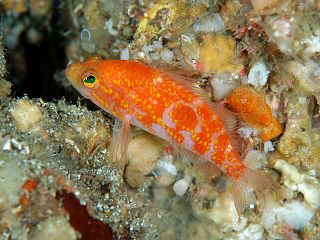Pierre Fourmanoir (1924–2007) was a French ichthyologist working mainly in New Caledonia. He described many new species of fish including several sharks.
Plectranthias sheni is a species of marine fish belonging to the family Serranidae. It has only been recorded off the coast of Taiwan. Although only recently described, examples of this fish have been known for some time but have been misidentified as the more widespread species Plectranthias anthioides and Plectranthias kamii.
Plectranthias whiteheadi, Whitehead's basslet, is a species of fish in the family Serranidae occurring in the Western Pacific. Little is known about this relatively small species which maximum length is about 7.8 cm SL.
Peter Robert Last is an Australian ichthyologist, curator of the Australian National Fish Collection and a senior principal research scientist at CSIRO Marine and Atmospheric Research (CMAR) in Hobart, Tasmania. He is an elasmobranch expert and has described many new species of shark.
Alwyne (Wyn) Wheeler was a British ichthyologist who was a curator at the Natural History Museum in London. He was educated at St Egbert's College, Chingford, and Chingford County High School to Higher School Certificate level, and was unusual in that his subsequent scientific career was achieved despite his never having obtained a university degree.
Loren Paul Woods (1913–1979) was an American ichthyologist and museum curator at the Field Museum of Natural History In Chicago. He joined the museum's education department as a guide lecturer in 1938. In 1941, he was transferred to the Division of Fishes, from where he retired in 1978. His career was interrupted by a four-year period of duty with the United States Navy during World War II. While he was in the navy, Marion Griswold Grey served as the unpaid curator, becoming an associate at the museum when Woods resumed his post. During his time at the Field Museum, he assembled specimen collections of North American freshwater fish and Atlantic, Indian, and Pacific Ocean marine fish. This material resulted in a major expansion of the museum's fishes holdings, which had previously been a mostly freshwater collection. Woods is best remembered for his publications on damselfish, squirrelfish, and Berycidae.
Nikolai Vasilyevich Parin was a Soviet and Russian ichthyologist, specializing in oceanic pelagic fish. He headed the Laboratory of Oceanic Ichthyofauna at the RAS Institute of Oceanology in Moscow, where he ended his career as a Professor after more than fifty-seven years. In his career, he described more than 150 new taxa of fish and participated in 20 major oceanic expeditions. Thirty-six species of fish are named in his honour.
Marie-Louise Bauchot is a French ichthyologist and assistant manager of the National Museum of Natural History, France.

Tosanoides annepatrice is a species of reef fish in the family Anthiadidae. It is native to the western Pacific Ocean around Palau and Micronesia and can be found in depths of 115–150 meters.
Plectranthias jothyi is a species of ray-finned fish within the family Serranidae. It is native to the Indo-Pacific Ocean off Malaysia, living in pelagic waters 180 to 400 meters below sea level. It grows to a length of 9.2 centimeters.

Plectranthias takasei, the Hinomaru perchlet, is a species of fish in the family Serranidae.
Plectranthias taylori is a species of fish in the family Serranidae occurring in the eastern-central Pacific Ocean.
Plectranthias wheeleri, the spotted perchlet, is a species of fish in the family Serranidae occurring in the western Pacific Ocean.
Plectranthias alleni, also known as Allen's perchlet, is a species of fish in the family Serranidae occurring in the eastern Indian Ocean.

Plectranthias bennetti, or Bennett's perchlet, is a species of fish in the family Serranidae occurring in the western Pacific Ocean.
Plectranthias japonicus, the Japanese perchlet, is a species of fish in the family Serranidae described from Japan. It also occurs in the south-eastern Indian Ocean and the western Pacific Ocean from the Philippines north to Taiwan and Japan, and off of the Northern Territory of Australia.

Plectranthias kelloggi, also known as eastern flower porgy, is a species of fish in the family Serranidae occurring in the western Pacific Ocean.
Plectranthias klausewitzi is a species of fish in the family Serranidae occurring in the western Indian Ocean.
Plectranthias nazcae, the red splodge, is a species of fish in the family Serranidae occurring in the southern Pacific Ocean.
Plectranthias parini, Parin's anthias, is a species of fish in the family Serranidae occurring in the south-eastern Pacific Ocean.



